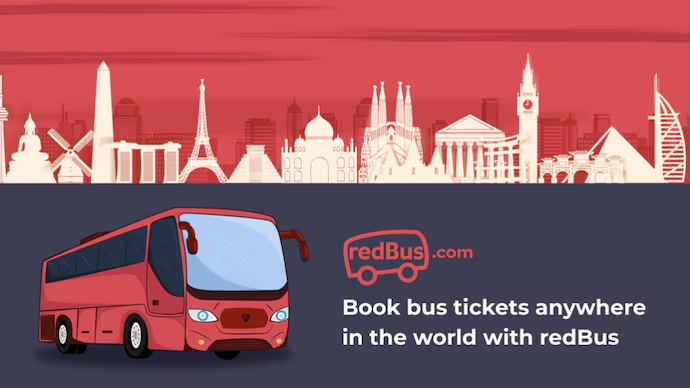Traditionally, travelers had to physically visit bus stations or rely on travel agents, often facing issues like lack of transparency, uncertain availability, and no guarantee of seat selection. But RedBus has transformed the way people travel by bus, making it easier, faster, and more reliable to book tickets online.
The idea for RedBus was born out of Phanindra’s personal experience of struggling to find a bus ticket home during Diwali. Frustrated with the traditional, fragmented, and unreliable ticket booking system, Phanindra Sama, Sudhakar Pasupunuri, and Charan Padmaraju envisioned a solution that would leverage technology to simplify the process.

They recognized that millions of other Indians faced frustrations and saw a clear opportunity to streamline and digitize the bus ticket booking process. There was also a lack of competition in the digital space.
So, they developed a platform where users could book bus tickets online, compare prices, and choose seats—all from the comfort of their homes. RedBus officially launched in August 2006 and quickly gained traction.
STP and SWOT Analysis
Segmentation:
- Demographic Segmentation:RedBus found that young professionals, college students, and middle-income groups were more likely to travel by bus frequently and were also more open to using digital platforms for booking.
- Geographic Segmentation:
Initially, cities like Bangalore, Mumbai, Delhi, and Chennai were prime targets due to their large populations and frequent intercity travel needs.
- Behavioral Segmentation:
Frequent travelers and those who planned their trips in advance were more likely to use an online platform like RedBus.
They also identified a segment of last-minute bookers who valued the convenience of quick and easy bookings.
Targeting:
Primary Target Audience:
- Young Professionals:
Tech-savvy individuals aged 20-35 who frequently travel for work or leisure.
- College Students:
Students who travel between their hometowns and educational institutions, often seeking affordable travel options.
- Middle-Income Families:
Families planning vacations or visiting relatives, looking for reliable and comfortable bus services.
Secondary Target Audience:
- Senior Citizens:
Older adults who prefer the convenience of pre-booked travel and seat selection.
- Tourists:
Both domestic and international tourists traveling within India, who require a reliable and easy way to book bus tickets.
Positioning:
RedBus positioned itself as the most convenient and reliable platform for bus ticket booking. They emphasized ease of use, a wide range of options, and a hassle-free travel experience.
Strengths:
- Market Leader:
RedBus is the leading online bus ticket booking platform in India, with a strong brand presence and loyal customer base.
- Wide Network:
Partnerships with thousands of bus operators provide users with extensive travel options.
- Technological Innovations:
Advanced technology, including a robust mobile app and real-time bus tracking, enhances user experience.
- Mobile App:
The RedBus app, with over 5 crore downloads, offers a seamless booking experience on the go.
Weaknesses:
- Rural Penetration:
While RedBus is strong in urban areas, rural penetration remains a challenge due to lower internet usage.
- Dependency on Bus Operators:
The platform’s reliability is heavily dependent on the performance and punctuality of bus operators.
- Building Trust:
Convincing bus operators to join the platform and ensuring users trusted online bookings were initial hurdles.
Opportunities:
- Expansion to New Markets:
Opportunities to expand services in rural areas and internationally.
- Value-Added Services:
Potential to introduce additional services such as travel insurance, hotel bookings, and holiday packages.
Threats:
- Competition:
Increasing competition from other online travel agencies and new entrants in the market.
- Price Wars:
Competitors offering lower prices or better deals can impact market share.
With this, RedBus has maintained its leadership in the market while continuing to innovate and adapt to changing market dynamics.
Competitor Analysis
- MakeMyTrip and Goibibo:
These online travel agencies (OTAs) offer a comprehensive suite of travel products including flights, hotels, and bus tickets. Their strong brand recognition and diverse offerings position them as formidable competitors.
- AbhiBus:
Primarily focused on bus ticketing, AbhiBus presents a direct challenge to RedBus’s market leadership.
- Ixigo:
Another OTA with a strong emphasis on technology, Ixigo competes by providing a user-friendly platform and competitive pricing for bus tickets.
To stay ahead in the competitive landscape, RedBus employs several strategies that differentiate it from its competitors and provide a competitive advantage:
- Early Mover Advantage:
As one of the pioneers in the online bus ticketing space, RedBus has a first-mover advantage, allowing it to build a strong customer base and brand image.
- Strong Partnerships:
RedBus has cultivated robust partnerships with bus operators, providing it with a competitive edge in terms of inventory and pricing.
- Focus on Tier II and III Cities:
While competitors often focus on major metropolitan areas, RedBus has successfully tapped into the potential of smaller cities, expanding its reach.
In 2019, 57% of total bookings on RedBus came from Tier 2 and 3 cities.
- Innovation:
RedBus has introduced several innovative features, such as live bus tracking and seat selection, enhancing the customer experience.
- Customer Support:
The company has invested heavily in customer support, ensuring prompt and efficient assistance to customers.
RedBus currently has a market share of 70%! Its strategic approach makes it a leading player in a highly competitive and evolving industry.
Marketing Mix
Product:
At its core, RedBus provides a platform for booking bus tickets across India. The service connects travelers with thousands of bus operators, offering a wide range of options from luxury coaches to budget-friendly buses.
Users can choose seats, compare prices, read reviews, and book tickets conveniently through the RedBus website or mobile app.
RedBus has continuously innovated to enhance the user experience. Some notable enhancements include:
- Real-Time Bus Tracking:
This feature allows users to track their bus in real-time, providing updates on arrival times and delays.
- Rating System:
Passengers can rate their travel experience, helping others make informed choices and encouraging bus operators to maintain high service standards.
- Insurance Options:
RedBus offers travel insurance, giving users peace of mind in case of unforeseen circumstances.
- Multiple Payment Options:
Users can pay via various methods including credit/debit cards, net banking, mobile wallets, and even cash on delivery.
Price:
RedBus uses a dynamic pricing model where ticket prices vary based on demand, season, and booking time. This flexible pricing helps maximize revenue while offering competitive rates to travelers.
To attract and retain customers, RedBus regularly offers discounts and promotional deals. These include:
- Seasonal Offers:
Discounts during festive seasons and holidays.
- Cashback Deals:
Collaborations with payment partners to offer cashback on bookings.
- Referral Programs:
Incentives for existing users to refer new customers to the platform.
Place:
RedBus primarily operates through its digital platform, which includes a website and mobile app. This online presence ensures easy access for users across the country. They also have a strong presence on social media, where they engage with customers and promote their services.
Promotion:
RedBus has launched several digital advertising campaigns to build brand awareness and attract new users.
SEO:
In June 2024, here is how the website’s SEO analytics looked like for RedBus:

Out of these, 83.37% of the visitors came from mobile while 16.63% were from desktop. The lower bounce rate shows that their website is well-optimized to function in a consumer-centric manner.
Their organic search traffic was 21.08M while the paid search traffic was 262.4K. This shows that their website is well-optimized to rank on search and their brand identity is credible enough for potential users to trust them.
Email Marketing:
Email marketing has been a part of RedBus’ strategy. However, they faced a low email open rate for feedback requests, averaging 7.03%, compared to the industry standard of 15-20% for marketing emails.
To tackle this, RedBus:
Understood User Behavior: Analyzed customer travel patterns and email engagement.
Optimized Sending Times: Identified peak travel days (Friday, Saturday, Sunday nights) and optimal email opening times (Monday mornings).
Personalized Delivery: Tailored email delivery based on individual travel schedules.
This increased email open rates from 7% to 13%. By matching up their emails with what customers were doing, RedBus showed that using data can really pay off.
Instagram Marketing:
Currently, redbusindia has 40.7K followers on Instagram. Their content mix includes staying on top of current trends. They also collaborate to increase reach and credibility:

To incentivize engagement and purchases, they also create contests on social media. These help them reach their target audience and stay in touch with existing and potential customers.
Ad Campaigns:
RedBus roped in Allu Arjun as the brand ambassador and created a series of ad films. For instance:
This shows how RedBus offers the convenience of reserved seats. They also created one that highlights the common hassles of bargaining for a bus ticket and positioning RedBus as the better option with better prices:
These ad films help to create an enhanced brand recall and recognition among target audiences.
In a Nutshell
RedBus’ success story is a testament to the power of identifying a gap in the market and leveraging technology to create a solution that resonates with consumers. By focusing on customer needs and delivering a seamless user experience, RedBus has established itself as a dominant player in the online bus ticketing industry.
Their strategic approach, including a strong emphasis on technology and customer support, has been instrumental in their growth and market leadership.
Key Takeaways from RedBus’ Marketing
Understand your target audience deeply to tailor your marketing efforts effectively.
Leverage technology to create a seamless and convenient customer experience.
Prioritize customer satisfaction through excellent service and support.
Utilize data-driven insights to optimize marketing campaigns and make informed decisions.
Invest in digital marketing channels to reach a wider audience.


